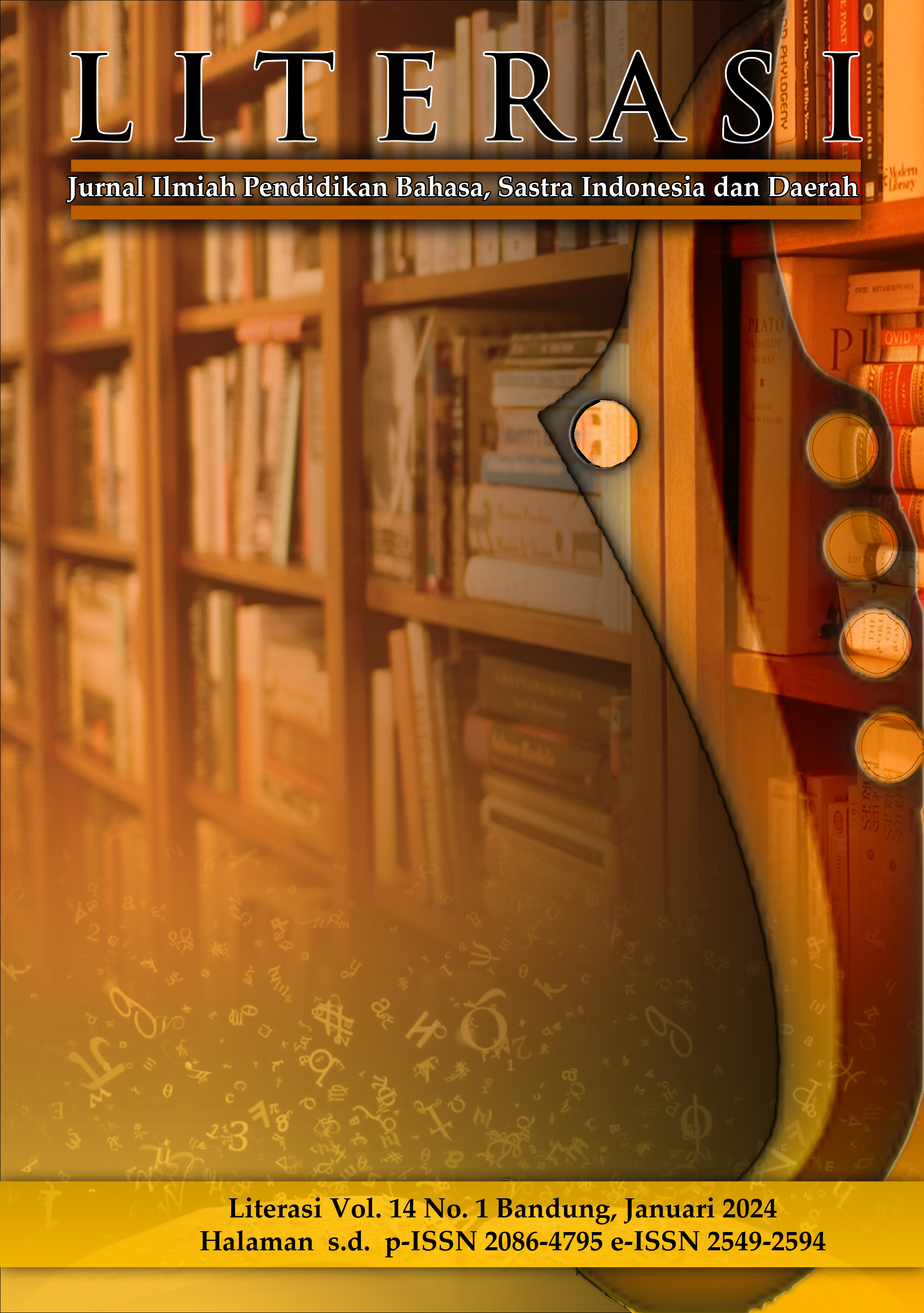POLA, MAKNA, SERTA FUNGSI PENGAPLIKASIAN SLANG PADA KALANGAN REMAJA DI KABUPATEN/KOTA BANDUNG
DOI:
https://doi.org/10.23969/literasi.v14i1.11513Keywords:
Slang, Patterns, Meaning, Functions, Sundanese Language, BandungAbstract
Slang is one of the variations of social language that grows among people. Using slang in informal situations for adolescents serves as self-familiarity with other individuals. This research investigates the patterns, meaning, and functions of Sundanese slang in Bandung City/Regency. This research method uses a mix methods of qualitative and quantitative. The researcher collected the data through questionnaires via Google Forms with specific participant criterias to gain appropriate results. Twenty participants were selected based on age, birth, domicile in Bandung City/Regency, and Sundanese as their native language. In analysing the data, the researcher used O'Grady's (1996) theory regarding the word formation process. The results of this study indicate that the word formation processes of Sundanese slang is formed through the types of onomatopoeia (2.81%), derivation (4.22%), multiple processes, (7%) clipping, (8,45%), coinage (22.5%), acronym (24.6%), and blending (30.3%). In addition, slang functions were found into seven types, for humor, mockery, praise, brevity and concreteness, confidentiality, intimacy, and as an identity and group differentiator.
Downloads
References
Amrullah, Latif. (2018). Slang Bahasa Inggris di Dunia Maya. Yogyakarta: Gadjah Mada.
Auni, A. G. (2018). The Use of Sundanese Slang by Teenagers in an Internet-Based Chat Application. Passage, 6(1), 40-57.
Chaer, Abdul. (2003). Linguistik Umum. Jakarta: Rineka Cipta
Chaer, Abdul. (2015). Morfologi Bahasa Indonesia: pendekatan proses. Jakarta: Rineka Cipta.
Chaer A. dan Agustina L. (2010). Sosiolinguistik Perkenalan Awal. Jakarta: Rineka Cipta.
Darmadi, Hamid. (2013). Metode Penelitian Pendidikan dan Sosial. Bandung: Alfabeta.
Fromkin, Victoria and Rodman Robert. (1983). An Introduction to Language. 4thEdition. New York: Holt. Rinehart and Winston, Inc.
Joos, M. (1962). The Five Clocks. New York: Harcourt Brace.
Katamba. F. (1993). Morphology. Basingstoke: Macmillan
Khoirurrohman, T., & Rohmad Abdan, M. (2020). Analisis Pemakaian Variasai Bahasa Slang Pada Remaja Desa Kalinusu: Kajian Sosiolinguistik. Jurnal Ilmiah SEMANTIKA, 1(02), 1–11. DOI: https://doi.org/10.46772/semantika.v1i02.165
Kridalaksana, Harimurti. (1982). Introduction to Word Formation and Word Classes. Jakarta: Universitas Indonesia.
Labov, W. (1972). Sociolinguistic patterns. Philadelphia: University of Pennsylvania Press
Marchand, H. (1992). The Categories and Types of Present-day English Word Formation. 2-nd Edition. Munich: C.H. Becksche Verlaegsbuchhandlung
Mulyana. (2008). Bahasa Indonesia untuk Perguruan Tinggi. Rembang: Yayasan Adhigama.
O’Grady, W. Dobrovolsky, M, Katamba, F. (1996). Contemporary Lingusitics. Edinburgh: Longman
O’Grady, Wiliam and Guzman. (1996). Morphology: the analysis of word structure. United Kingdom: Longman
Sugiyono. (2018). Metode Penelitian Kuantitatif, Kualitatif, dan R&D. Bandung: Alfabeta.
Sulaeman, A., & Dwihudhana, W. (2019). Hubungan Motivasi Belajar terhadap Hasil Pembelajaran Bahasa Indonesia bagi Penutur Asing (BIPA) pada Mahasiswa Semester 7 Program Studi Pendidikan Bahasa dan Sastra Indonesia FKIP Universitas Muhammadiyah Tangerang. Silampari Bisa: Jurnal Penelitian Pendidikan Bahasa Indonesia, Daerah, dan Asing, 2(1), 60. doi:10.31540/silamparibisa.v2i1.327
Sulaeman. A. (2020). Bahasa Slang Generasi Muda dalam Media Sosial di Era Milenial. Prosiding Seminar Nasional Bulan Bahasa (Semiba) 2019. Hal. 45-54. https://ejournal.unib.ac.id/index.php/semiba/article/view/10275
Sumantri. M., et al. (1985). Kamus Sunda-Indonesia. Jakarta: Pusat Pembinaan dan Pengembangan Bahasa
Sharifian, Farzad. (2015). The Routledge Handbook of Language. New York: Routledge.
Yule, George. (2010). The Study of Language. Cambridge University Press.
Downloads
Published
Issue
Section
License
Copyright (c) 2024 Literasi: Jurnal Ilmiah Pendidikan Bahasa, Sastra Indonesia dan Daerah

This work is licensed under a Creative Commons Attribution 4.0 International License.
Hak cipta artikel yang diterbitkan di jurnal ilmiah dimiliki oleh penerbit, bukan penulis. Hal ini berkaitan dengan koordinasi hak akses untuk cetak ulang atau penggunaan lainnya. Dalam hal ini penerbit mempunyai keluluasaan untuk mempublikasikan artikel sesuai dengan kesepakanan Transfer Agreement (penyerahan hak cipta) antara penerbit dengan penulis.















